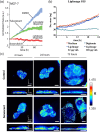Perspective on quantitative phase imaging to improve precision cancer medicine
- PMID: 38584967
- PMCID: PMC10996848
- DOI: 10.1117/1.JBO.29.S2.S22705
Perspective on quantitative phase imaging to improve precision cancer medicine
Abstract
Significance: Quantitative phase imaging (QPI) offers a label-free approach to non-invasively characterize cellular processes by exploiting their refractive index based intrinsic contrast. QPI captures this contrast by translating refractive index associated phase shifts into intensity-based quantifiable data with nanoscale sensitivity. It holds significant potential for advancing precision cancer medicine by providing quantitative characterization of the biophysical properties of cells and tissue in their natural states.
Aim: This perspective aims to discuss the potential of QPI to increase our understanding of cancer development and its response to therapeutics. It also explores new developments in QPI methods towards advancing personalized cancer therapy and early detection.
Approach: We begin by detailing the technical advancements of QPI, examining its implementations across transmission and reflection geometries and phase retrieval methods, both interferometric and non-interferometric. The focus then shifts to QPI's applications in cancer research, including dynamic cell mass imaging for drug response assessment, cancer risk stratification, and in-vivo tissue imaging.
Results: QPI has emerged as a crucial tool in precision cancer medicine, offering insights into tumor biology and treatment efficacy. Its sensitivity to detecting nanoscale changes holds promise for enhancing cancer diagnostics, risk assessment, and prognostication. The future of QPI is envisioned in its integration with artificial intelligence, morpho-dynamics, and spatial biology, broadening its impact in cancer research.
Conclusions: QPI presents significant potential in advancing precision cancer medicine and redefining our approach to cancer diagnosis, monitoring, and treatment. Future directions include harnessing high-throughput dynamic imaging, 3D QPI for realistic tumor models, and combining artificial intelligence with multi-omics data to extend QPI's capabilities. As a result, QPI stands at the forefront of cancer research and clinical application in cancer care.
Keywords: cancer research; computational imaging; interferometry; quantitative phase imaging.
© 2024 The Authors.
Figures






Similar articles
-
Prescription of Controlled Substances: Benefits and Risks.2025 Jul 6. In: StatPearls [Internet]. Treasure Island (FL): StatPearls Publishing; 2025 Jan–. 2025 Jul 6. In: StatPearls [Internet]. Treasure Island (FL): StatPearls Publishing; 2025 Jan–. PMID: 30726003 Free Books & Documents.
-
Off-axis digital lensless holographic microscopy based on spatially multiplexed interferometry.J Biomed Opt. 2024 Jun;29(Suppl 2):S22715. doi: 10.1117/1.JBO.29.S2.S22715. Epub 2024 Aug 19. J Biomed Opt. 2024. PMID: 39161785 Free PMC article.
-
CellSNAP: a fast, accurate algorithm for 3D cell segmentation in quantitative phase imaging.J Biomed Opt. 2024 Jun;29(Suppl 2):S22706. doi: 10.1117/1.JBO.29.S2.S22706. Epub 2024 Apr 18. J Biomed Opt. 2024. PMID: 38638450 Free PMC article.
-
Innovations in cancer treatment: evaluating drug resistance with lab-on-a-chip technologies.Int J Pharm. 2025 Sep 15;682:125936. doi: 10.1016/j.ijpharm.2025.125936. Epub 2025 Jul 5. Int J Pharm. 2025. PMID: 40623610 Review.
-
Management of urinary stones by experts in stone disease (ESD 2025).Arch Ital Urol Androl. 2025 Jun 30;97(2):14085. doi: 10.4081/aiua.2025.14085. Epub 2025 Jun 30. Arch Ital Urol Androl. 2025. PMID: 40583613 Review.
Cited by
-
Multimodal whole slide image processing pipeline for quantitative mapping of tissue architecture and tissue microenvironment.Npj Imaging. 2025 Jun 10;3:26. doi: 10.1038/s44303-025-00088-w. eCollection 2025. Npj Imaging. 2025. PMID: 40510252 Free PMC article.
-
An Omni-Mesoscope for multiscale high-throughput quantitative phase imaging of cellular dynamics and high-content molecular characterization.Sci Adv. 2024 Oct 18;10(42):eadq5009. doi: 10.1126/sciadv.adq5009. Epub 2024 Oct 16. Sci Adv. 2024. PMID: 39413179 Free PMC article.
-
Long-term three-dimensional high-resolution imaging of live unlabeled small intestinal organoids via low-coherence holotomography.Exp Mol Med. 2024 Oct;56(10):2162-2170. doi: 10.1038/s12276-024-01312-0. Epub 2024 Oct 1. Exp Mol Med. 2024. PMID: 39349827 Free PMC article.
-
Rapid mechanical phenotyping of breast cancer cells based on stochastic intracellular fluctuations.iScience. 2024 Oct 4;27(11):110960. doi: 10.1016/j.isci.2024.110960. eCollection 2024 Nov 15. iScience. 2024. PMID: 39493877 Free PMC article.
-
To label or not: the need for validation in label-free imaging.J Biomed Opt. 2024 Jun;29(Suppl 2):S22717. doi: 10.1117/1.JBO.29.S2.S22717. Epub 2024 Dec 20. J Biomed Opt. 2024. PMID: 39711795 Free PMC article. Review.
References
-
- Popescu G., Quantitative Phase Imaging of Cells and Tissues, 1st ed., McGraw-Hill Education, New York: (2011).
-
- Park Y., Depeursinge C., Popescu G., “Quantitative phase imaging in biomedicine,” Nat. Photonics 12(10), 578–589 (2018).NPAHBY10.1038/s41566-018-0253-x - DOI
Publication types
MeSH terms
Grants and funding
LinkOut - more resources
Full Text Sources
Medical
Research Materials

